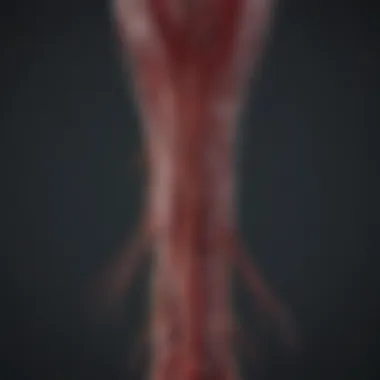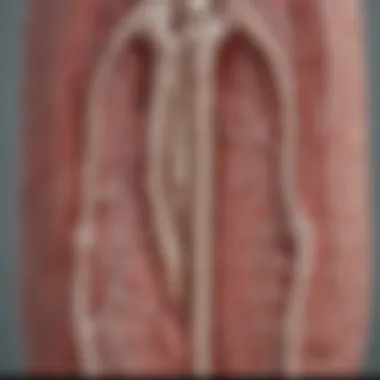Spinal Angiogram: Procedures, Insights, and Clinical Implications


Intro
In the realm of neurosurgery and radiology, spinal angiography has emerged as a critical tool for the assessment of vascular pathologies within the spinal column. Understanding its implications goes beyond mere comprehension of the procedure; it encompasses insights into spinal health, diagnosis, and treatment. Spinal angiography involves the visualization of blood vessels using advanced imaging techniques, providing a window into conditions that may otherwise remain hidden.
This article serves as a comprehensive guide, elucidating the procedures involved in spinal angiography, discussing its clinical relevance, and comparing it with alternative imaging modalities. As we navigate this topic, it is essential for medical professionals to grasp the underlying concepts, current research trends, and how these elements translate into better patient care.
Despite the inherent complexities of spinal vascular structures, a well-performed angiogram can reveal vital information. With this in mind, let's delve into the Key Concepts surrounding spinal angiography.
Prologue to Spinal Angiogram
Spinal angiography is a crucial imaging technique that provides insights into the vascular structures in the spinal region. This procedure allows medical professionals to visualize blood vessels, aiding in the diagnosis and treatment of various spinal conditions. Understanding spinal angiography is essential for those involved in neurosurgery, radiology, and related fields, as it enhances patient care by identifying issues that may not be apparent through traditional imaging methods.
Among its benefits, spinal angiography can detect vascular malformations, tumors, and ischemic conditions, offering a broader perspective on spinal health. The methodology involves a series of well-defined techniques that require careful execution. This ensures not only the quality of the images obtained but also the safety and comfort of the patient undergoing the procedure.
Overview of Angiographic Techniques
Angiography encompasses various techniques, each with unique characteristics designed for specific diagnostic purposes. Traditional contrast angiography remains prevalent. Digital subtraction angiography is increasingly favored due to its ability to enhance image clarity while reducing the volume of contrast media used. Furthermore, hybrid techniques combining angiography with other imaging modalities are gaining traction for providing comprehensive evaluations.
Recent advances have brought new tools that allow for a more accurate assessment of vascular conditions. Endovenous laser therapy, for instance, utilizes a laser to close off problematic veins and may be more effective when used alongside angiographic evaluations. As the technology progresses, radiologists must stay informed about emerging techniques to improve patient outcomes.
History and Development of Spinal Angiography
The development of spinal angiography can be traced back to the mid-20th century. Initial procedures utilized rudimentary techniques, which gradually evolved. With advancements in imaging technology, the precision of spinal angiography improved remarkably. The invention of digital imaging systems transformed how vascular conditions were diagnosed and treated.
Today, spinal angiography is not merely a diagnostic tool. It plays a vital role in surgical planning and post-operative assessments. Understanding its history provides context for current techniques and emphasizes the evolution toward safer and more effective methodologies in clinical practice.
"Spinal angiography has undergone substantial progress, reflecting the advancements in medical imaging technologies and their impact on patient care."
"Spinal angiography has undergone substantial progress, reflecting the advancements in medical imaging technologies and their impact on patient care."
In summary, spinal angiography represents a significant evolution in medical imaging that enhances our capacity to diagnose and treat complex spinal conditions. Its methodologies, rooted in a rich history of innovation, continue to shape the future of spinal health care.
Principles of the Procedure
Understanding the principles of spinal angiography is crucial for both practitioners and patients. This procedural knowledge forms the foundation of accurately visualizing the spinal vasculature. Mastery in the principles enhances diagnostic precision, selectively illuminates complications, and promotes effective patient management. It is essential to acknowledge that the principles integrate various critical steps, ranging from pre-procedural considerations to technical execution. Each stage carries weight in ensuring the patient's safety and the overall efficacy of imaging results.
Pre-procedural Considerations
Before proceeding with spinal angiography, careful assessment is vital. Clinicians must evaluate the patient's medical history and current health status. This includes a thorough review of existing conditions, medication use, allergies, and prior imaging studies. Moreover, patients should be informed about what to expect during the procedure, including potential discomfort and risks involved. A discussion around informed consent is also imperative; patients must fully understand the procedure's purpose, benefits, and any alternatives available.
In addition, adequate preparation often encompasses the following:
- Fasting: Patients may be required to fast for several hours before the procedure.
- Medication adjustments: Certain blood thinners or anticoagulants may need to be temporarily withheld.
- Family support: Encouraging family presence can help alleviate patient anxiety.
Anesthesia and Patient Positioning
The administration of anesthesia is a pivotal aspect that enhances patient comfort and cooperativeness during the spinal angiogram. Depending on the complexity of the procedure and patient preference, local or general anesthesia may be utilized. Local anesthesia minimizes discomfort while allowing the patient to remain conscious, whereas general anesthesia may be warranted for more intricate cases.
Patient positioning is equally important, as proper alignment facilitates optimal access to vessels. The patient is usually positioned prone on the angiography table. This position allows the clinician to gain better visibility and access to the lumbar or cervical spine, depending on the specific area under examination.
Contrast Agents: Selection and Administration
The use of contrast agents is essential in spinal angiography. These agents enhance the visibility of blood vessels, making it easier to identify abnormalities. Careful selection of contrast material is based on several considerations such as:


- Patient allergies: Ensure no history of hypersensitivity to contrast media.
- Kidney function: Evaluate renal performance to avoid complications related to nephrotoxicity.
Commonly used contrast agents include iodine-based media. They are typically administered using a catheter placed in the vascular system. The administration technique may vary based on the angiographic approach—whether it is via the femoral or radial artery.
Technical Steps of the Angiogram
The execution of a spinal angiogram involves a series of carefully orchestrated technical steps:
- Accessing the Artery: A catheter is introduced into a major artery. This is often done with guidance through fluoroscopic imaging.
- Catheter Navigation: The clinician navigates the catheter through the blood vessels to the target area in the spine. This requires precise control and understanding of vascular anatomy.
- Injection of Contrast Media: Once the catheter is in place, contrast agent is injected.
- Imaging Acquisition: Simultaneously, fluoroscopy captures real-time images. These are essential for assessing blood flow and identifying any pathologies.
- Post-procedural Monitoring: After completion, the patient is closely monitored for any immediate adverse reactions or complications.
The success of a spinal angiogram significantly depends on the clinician's skill and experience in navigating the vasculature and ensuring patient safety throughout the process.
The success of a spinal angiogram significantly depends on the clinician's skill and experience in navigating the vasculature and ensuring patient safety throughout the process.
Indications for Spinal Angiography
Spinal angiography serves as a critical diagnostic tool in numerous clinical settings. Understanding the indications for this procedure is vital for healthcare professionals who aim to provide precise diagnoses and effective treatment plans. This section will delve into various scenarios where spinal angiography is indicated, emphasizing its significance in managing spinal pathologies. The details that follow will help practitioners grasp when and why this imaging technique is necessary.
Assessment of Vascular Malformations
Vascular malformations, such as arteriovenous fistulas and vascular tumors, can significantly impair spinal vascular health. Spinal angiography can detect these malformations with high accuracy. The visualization of blood vessels through this method allows clinicians to assess the anatomy of vascular lesions precisely.
This assessment is essential because misdiagnosis can lead to rare complications like hemorrhagic events.
Key points include:
- Ability to visualize abnormal vascular structures.
- Determine the involvement of surrounding tissues.
- Guide therapeutic interventions, such as embolization or surgical resection.
A thorough understanding of these malformations and appropriate use of spinal angiogram can enhance patient outcomes.
Evaluation of Tumors Affecting the Spinal Vasculature
The presence of tumors in the spinal region often complicates the vascular landscape. Spinal angiography is invaluable for evaluating tumors affecting the spinal vasculature. It helps in determining tumor vascularity, which can influence treatment decisions, particularly in considering surgical resection versus other therapeutic modalities.
Benefits of this evaluation include:
- Identifying tumor feeding vessels, which aids surgical planning.
- Distinguishing between benign and malignant tumors based on vascular features.
- Monitoring treatment response and potential recurrence.
Understanding the vascular characteristics of tumors can greatly impact prognosis and management strategies.
Identification of Ischemic Conditions
Ischemic conditions in the spinal region may lead to significant neurological dysfunction. Spinal angiography assists in identifying areas of compromised blood flow. It provides essential insights into the underlying causes of ischemia, such as vascular occlusion or stenosis.
Important considerations are:
- Clarifying the extent and location of ischemia.
- Evaluating collateral circulation, which may help in rehabilitation.
- Facilitating interventions to restore blood flow, such as stenting or angioplasty.
This information is critical for timely intervention and may help prevent further neurological deterioration.
Other Diagnostic Considerations
Besides vascular malformations, tumors, and ischemia, spinal angiography has other pertinent diagnostic applications. Conditions like spinal infections and post-surgical complications can also benefit from this imaging technique.
- Spinal infections: Spinal angiography can reveal abnormal vascular patterns associated with infections like abscesses.
- Post-surgical evaluations: It helps assess complications such as hematomas or foreign bodies affecting vascular structures.


The versatility of spinal angiography for varied diagnostic purposes underscores its value in comprehensive spinal assessment.
Potential Risks and Complications
Understanding the potential risks and complications associated with spinal angiography is crucial for both clinicians and patients. Awareness of these factors allows healthcare professionals to better manage the procedure's overall safety and efficacy. It also facilitates informed decision-making by patients who may be anxious or uncertain about undergoing this complex imaging procedure. By addressing potential complications, clinicians can take preventative measures, leading to improved patient outcomes and satisfaction.
Common Adverse Effects
Many patients experience mild adverse effects following a spinal angiogram. These can include:
- Local pain or discomfort at the catheter insertion site
- Headaches, which may arise due to changes in cerebrospinal fluid pressure
- Nausea or mild vomiting, often related to the contrast agent or sedation given for the procedure
Fortunately, these symptoms often resolve quickly. Regular monitoring and clear patient communication can help alleviate concerns and manage these common reactions efficiently. Patients should be encouraged to report any discomfort immediately, as this allows for timely interventions and reassurances.
Rare but Serious Complications
While rare, the serious complications associated with spinal angiography necessitate careful consideration. Some of these complications include:
- Allergic reactions to the contrast agent, which can range from mild rashes to severe anaphylactic responses
- Vascular injury, potentially resulting in hematoma formation or thrombosis
- Infection at the catheter site, which may lead to more generalized systemic issues
- Neurological deficits, which may occur from inadvertent damage to nerves or other vascular structures during the procedure
When managing these risks, it is essential that providers conduct thorough pre-procedural evaluations, including a patient's medical history and any potential allergies. This proactive approach to patient care can significantly reduce the occurrence of severe complications.
Conclusion: Identifying and understanding both common and rare complications linked to spinal angiography is vital for enhancing patient safety and protocol adherence in medical practice.
Conclusion: Identifying and understanding both common and rare complications linked to spinal angiography is vital for enhancing patient safety and protocol adherence in medical practice.
Interpreting Spinal Angiograms
Interpreting spinal angiograms is a crucial phase in understanding vascular health within the spinal region. This section highlights the significance of proficient interpretation in guiding diagnosis and determining the best course of action for patient management. A thorough grasp of the components displayed in an angiogram influences clinical decisions profoundly. Proper interpretation requires collaboration among medical professionals, including radiologists and neurologists, to ensure a comprehensive approach.
Normal Findings
Normal spinal angiograms typically demonstrate a well-defined arrangement of blood vessels without any obstructions or abnormalities. Key points include:
- Vascular Supply: The vascular supply should visualize the anterior, posterior, and radicular arteries in their expected anatomical positions.
- Symmetry: There should be bilateral symmetry in the vascular structure, indicating healthy perfusion in the spinal column.
- Absence of Anomalies: There should be no evidence of vascular malformations such as arteriovenous fistulas or aneurysms.
Understanding these normal findings is critical for distinguishing between healthy vessels and pathological conditions. A well-executed angiogram can reassure clinicians of the spinal vasculature's integrity.
Pathological Findings
Pathological findings within spinal angiograms can indicate several conditions requiring prompt attention. Common abnormal results include:
- Vascular Malformations: Conditions like arteriovenous malformations may present with abnormal connections between arteries and veins, leading to altered blood flow.
- Tumors: Neoplastic growths may impinge on or invade nearby vessels, altering their morphology or creating collateral circulation patterns.
- Ischemic Changes: Signs of ischemia can manifest as reduced vascular supply due to blockage or compaction, impacting spinal health significantly.
Each of these pathological findings necessitates specific clinical interventions. Early detection through precise interpretation encourages timely treatment, which is crucial in improving patient outcomes. A comprehensive understanding of these findings aids professionals in making informed and effective decisions regarding patient management.
By interpreting spinal angiograms correctly, medical professionals can navigate complex conditions while ensuring optimal patient care.
By interpreting spinal angiograms correctly, medical professionals can navigate complex conditions while ensuring optimal patient care.
Comparative Analysis with Other Imaging Modalities
The landscape of spinal imaging continues to evolve with technological advancements. Spinal angiography is an essential tool, but it is not the only imaging modality available. Comparing it with other techniques, like Magnetic Resonance Imaging (MRI) and Computed Tomography (CT) Angiography, can reveal its unique strengths and weaknesses. Understanding these nuances can help medical professionals make informed choices regarding patient care.
Spinal angiograms offer detailed visualization of the vascular system, essential for diagnosing conditions such as tumors or vascular malformations. However, MRI and CT also have their advantages. MRI is particularly effective in soft tissue evaluation, while CT is known for its speed in obtaining images. Each modality has specific indications, which can affect clinical decision-making.


Understanding the applications and limitations of various imaging modalities is crucial for optimal patient management.
Understanding the applications and limitations of various imaging modalities is crucial for optimal patient management.
Magnetic Resonance Imaging (MRI)
MRI uses strong magnetic fields and radio waves to generate images of the spine and its associated structures. One of its primary benefits is the high contrast resolution for soft tissues, which allows for clear differentiation between various spinal elements, including nerves, discs, and ligaments. This makes it indispensable in assessing certain conditions, such as spinal cord compression or disc herniation.
However, there are differences worth noting between MRI and spinal angiography. MRI does not visualize blood vessels directly, which limits its effectiveness when vascular abnormalities must be assessed. Thus, while MRI can provide comprehensive views of the spinal anatomy, it may fall short in identifying vascular lesions that a spinal angiogram would reveal.
Computed Tomography (CT) Angiography
CT Angiography involves the injection of contrast material followed by imaging using a CT scanner. This method provides rapid imaging of blood vessels and is particularly advantageous in acute settings, where time is of the essence. Its ability to portray vascular structures makes it a strong contender in the diagnostic imaging toolkit.
CT angiography excels in situations involving trauma to the spine, as it offers quick and reliable access to vascular injury assessment. However, its sensitivity is less than that of a spinal angiogram for certain conditions, such as subtle vascular malformations. Moreover, the ionizing radiation involved in CT has potential risks that may influence its use in priority decision-making regarding patient safety.
Future Directions in Spinal Angiography
The field of spinal angiography is evolving rapidly, spurred by advancements in medical imaging technology and the increasing need for precise diagnostic capabilities in neurosurgery and related fields. As healthcare continues to advance, there is a pressing need to examine the future directions in this area. The integration of novel imaging techniques and clinical applications can significantly enhance the role of spinal angiography in diagnosing and managing spinal conditions. This discussion aims to provide insights into the innovations and emerging applications that are shaping the future of this vital diagnostic tool.
Innovations in Imaging Technology
Recent years have seen significant progress in imaging technology that impacts spinal angiography. Innovations such as enhanced digital imaging and improved resolution of imaging modalities are making it possible to visualize spinal vessels more clearly. For example, 3D rotational angiography allows for better spatial understanding of vascular anatomy. This technique offers dynamic imaging, providing a comprehensive view that helps in planning surgical interventions.
Furthermore, the development of artificial intelligence in image analysis can enhance interpretation, allowing for faster and more accurate diagnosis of vascular abnormalities. AI algorithms can assist radiologists by detecting patterns in angiograms that may be overlooked by the human eye. These advancements hold promise for increasing efficiency in diagnostic workflows.
- Enhanced imaging resolution
- 3D rotational angiography
- Artificial intelligence in image analysis
In addition, portable imaging devices and telemedicine are becoming increasingly relevant. These technologies may facilitate remote evaluations and consultations, making spinal angiography more accessible in various healthcare settings.
Emerging Clinical Applications
With the ongoing evolution of spinal angiography, several emerging clinical applications are noteworthy. One significant area is the assessment of complex vascular malformations. As imaging technology progresses, vascular malformations that were previously difficult to diagnose can now be evaluated more effectively. This is particularly important in conditions like arteriovenous malformations and dural arteriovenous fistulas, where precise localization and characterization are essential for treatment planning.
Another emerging application is in pre-operative planning, especially for spinal tumors. High-definition angiograms can assist surgeons in understanding the vascular supply to tumors, which is vital for minimizing intraoperative complications. Understanding the blood supply also aids in postoperative care, as targeted therapies and follow-up can be thoughtfully planned.
The integration of advanced imaging techniques will redefine our understanding of spinal vascular conditions, enhancing diagnostic accuracy and patient outcomes.
The integration of advanced imaging techniques will redefine our understanding of spinal vascular conditions, enhancing diagnostic accuracy and patient outcomes.
In terms of treatment, spinal angiography is being explored for therapeutic applications, such as embolization procedures. This minimally invasive approach can mitigate risks associated with traditional surgical methods when dealing with complex vascular issues.
In summary, the future of spinal angiography lies in the convergence of innovative imaging technologies and evolving clinical applications. As these advancements unfold, they have the potential to drastically improve diagnostic accuracy and patient safety in the realm of spinal care. Continuous research is crucial to fully realize these benefits and address the challenges that may arise from the integration of new technologies.
Culmination
The conclusion is a critical part of this article, summarizing the essence of spinal angiography and its manifold applications. Spinal angiography is not just a procedure but a gateway to a clearer understanding of spinal vasculature. Its value extends well beyond image acquisition; it provides crucial insights for diagnosing various spinal conditions.
Summary of Key Insights
Spinal angiography serves multiple purposes, notably:
- Diagnosing Conditions: It effectively identifies vascular malformations and tumors. Clinicians have a detailed view of potential ischemic conditions, enhancing treatment plans.
- Technical Considerations: The steps involved are methodical, from pre-procedural assessments to the technical execution of the angiogram itself.
- Risk Assessment: Although there are associated risks, they are generally manageable with proper protocols. Understanding both common adverse effects and rare complications is essential for medical professionals.
Through these insights, the article aims to equip practitioners and researchers with the necessary knowledge to utilize spinal angiography effectively.
Implications for Future Research
Future studies on spinal angiography may focus on several key areas:
- Technological Advancements: Innovations in imaging technology can lead to enhanced resolution and accuracy, potentially changing diagnostic standards.
- Broader Clinical Applications: Emerging research can explore the use of spinal angiography in less conventional cases, possibly expanding its diagnostic repertoire.
- Patient-Centric Approaches: Research may also shift towards minimizing risks and developing strategies that enhance patient safety and comfort during procedures.







